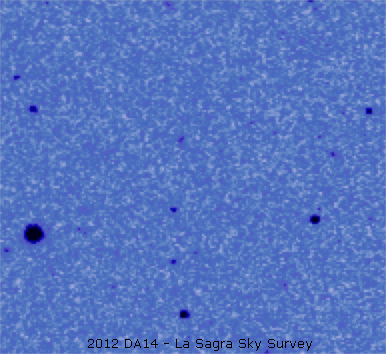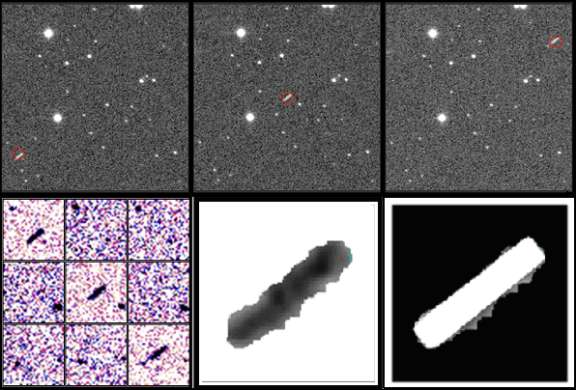Jaime Nomen • Mar 27, 2012
La Sagra Observatory discovers very near-Earth asteroid 2012 DA14
by Jaime Nomen and the La Sagra team
February 22, 2012 began as a routine night at the La Sagra Observatory. After several months of experimenting with surveillance of space debris, we had recently returned to our Sky Survey program and our search for near-Earth objects. On this particular night we had well covered most of the sky, so we decided to search at very high declinations, far from the ecliptic plane, and on the eastern sky, where the first light of morning would soon arrive.
The best time for asteroid discovery is during the two weeks around the new Moon (a period referred to as a "dark run"). Toward the end of each month's dark run, the sky has been very well covered by the big American surveys. So at La Sagra we have introduced some observing strategies especially for these times, designed to improve our chances of discovering new asteroids that the large surveys may miss. In particular, we try to find smaller objects located close to Earth. These appear suddenly and generally move at high angular speed. They may appear anywhere in the sky, even if that sky region had already been well searched just days previously.
Our strategies involve reducing the exposure times to prevent the fast-moving asteroids from making long trails, as well as taking images more frequently in order to increase the chances that we will get at least three images of an object before it escapes from our field of view.
At La Sagra, our off-the-shelf commercial CCD cameras have a rather slow read-out time, close to 1 minute!. This is the time it takes to transfer an exposure from the CCD to the computer. These long read-out times have been our most limiting factor in our survey performance, making it difficult for us to obtain multiple images of these fastest-moving objects.
That changed last year. In 2010, we had received a Shoemaker NEO Grant from the Planetary Society, which we used to upgrade one of our three CCDs. This camera has a much faster read-out time, and has quickly outperformed the other two telescopes in detecting new objects. We reported last year about ten new near-Earth objects discovered with it. More recently, it discovered comet C/2012 B3 (La Sagra) and a very special near-Earth object, 2012 DA14. Below I will explain why it is special.
In addition to the observing strategies I mentioned earlier, we made some changes to our processing software, using filtering tools that we developed and refined during our space debris observing campaign. One of these tools generates an expected trail that should be left by fast-moving objects in the images, and the software tries to match it.
With the new CCD camera configured to shoot rapid, short exposures, and with the help of these software tools, we caught 2012 DA14. It was moving at almost 11 arcseconds per minute of time. This is slower than a satellite but quite fast for near-Earth objects, equivalent to a lunar diameter every three hours.
The asteroid was detected automatically. Almost as soon as the images were taken, the processing software flagged the new near-Earth object candidate and labeled it 22MB316. We performed an immediate follow-up observation with another telescope to try to confirm it and to prevent it getting lost. As soon as we had confirmed it, we reported it to the Minor Planet Center, where it was listed on their near-Earth object confirmation page. This page lists newly discovered near-Earth objects so that astronomers around the world can obtain follow-up images to confirm that it is truly an asteroid, and to help determine its orbit.

These follow-up observations told us more about 2012 DA14. It is approximately 50 meters wide (similar in size to the object that caused the Tunguska blast in 1908). It was first detected when it was already leaving us, at 4,335,000 kilometers from Earth. Its closest approach to Earth had already passed one week before at some more than 2,600,000 kilometers. Considering its path on the eastern sky, its rather fast angular motion, the quite faint (and fading) brightness, and the high declination, very far from the ecliptic plane, it had been an slippery target, and easily could have escaped undetected during this encounter, with no option to predict its next really close encounter.
The preliminary orbit shows that 2012 DA14 has a very Earth-Like orbit with a period of 366.24 days, just one more day than our terrestrial year. The orbit is nearly circular but just elliptical enough to jump inside and outside of the path of Earth two times per year. Because objects move faster when they are closer to the Sun, the relative motion is similar to some sports races: when the Earth is on the outer track, it is overtaken by 2012 DA14, but when the asteroid crosses Earth's orbit, Earth overtakes it and passes by. It is during the orbit crossings when the closest encounters occur, and when there is potential for a future impact.
Fortunately, the orbit of 2012 DA14 is such that it will not crash into Earth for the foreseeable future. However, we will enjoy an extremely close approach at about 28,500 kilometers in less than one year, on February 15, 2013! The approach is actually even closer than that, because the distance is relative to Earth's center; subtract about 6,500 kilometers to get the altitude of its flyby, 22,000 kilometers. This distance is below that of many commercial satellites, and will allow not only a fun astronomical event, but an opportunity to carry out physical studies by radar imaging and tracking. Tracking is especially important because with such a close approach to Earth, our planet's gravity will change its future path and its odds of impacting us. Therefore, observing 2012 DA14 will provide a good test as we anticipate the 2029 flyby of Apophis, a bigger asteroid (around 270 meters) that is expected to have a very close encounter too, at around 36,000 kilometers.
If the orbit that has been derived from the available data is accurate, during the closest approach of next year, 2012 DA14 will be visible from Europe and Asia as an 6 - 7th magnitude star (easily seen by binoculars), crossing the sky from the southwest to the northeast at a speed of almost one Moon diameter per minute. For some time near its closest approach the asteroid will be disappearing inside Earth's shadow cone. But all of this awaits confirmation, as more follow-up observations establish a longer arc and improve the accuracy of our orbit determination.
And just think: a body on such an Earth-Like orbit, with these short periodic close encounters with Earth, would seem of great interest as a target for science missions to the asteroid or for testing technology designed to prevent a future impact!
See you next year!
Support our core enterprises
Your support powers our mission to explore worlds, find life, and defend Earth. You make all the difference when you make a gift. Give today!
Donate

 Explore Worlds
Explore Worlds Find Life
Find Life Defend Earth
Defend Earth


